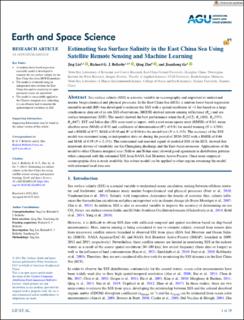Estimating Sea Surface Salinity in the East China Sea Using Satellite Remote Sensing and Machine Learning
| dc.contributor.author | Liu, Jing | |
| dc.contributor.author | Bellerby, Richard | |
| dc.contributor.author | Zhu, Qing | |
| dc.contributor.author | Ge, Jianzhong | |
| dc.date.accessioned | 2024-04-19T11:25:52Z | |
| dc.date.available | 2024-04-19T11:25:52Z | |
| dc.date.created | 2023-11-06T13:15:20Z | |
| dc.date.issued | 2023 | |
| dc.identifier.citation | Earth and Space Science. 2023, 10 (11), e2023EA003230. | en_US |
| dc.identifier.issn | 2333-5084 | |
| dc.identifier.uri | https://hdl.handle.net/11250/3127432 | |
| dc.description.abstract | Sea surface salinity (SSS) is a master variable in oceanography and important to understand marine biogeochemical and physical processes. In the East China Sea (ECS), a random forest based regression ensemble model (RF) was developed to estimate the SSS with a spatial resolution of ∼1 km based on a large synchronous data set of in situ SSS observations, MODIS-derived remote sensing reflectance (Rrs) and sea surface temperature (SST). The model showed the best performance when the Rrs(412), Rrs(488), Rrs(555), Rrs(667), SST and Julian day (JD) were used as inputs, with a root mean square error (RMSE) of 0.84, mean absolute error (MAE) of 0.31 and coefficient of determination (R2) of 0.81 for model training (N = 4,504), and a RMSE of 0.77, MAE of 0.30 and R2 of 0.86 for the model test (N = 1,153). The accuracy of the SSS model was examined using an independent data set during the period of 2020–2022 with a RMSE of 0.66 and MAE of 0.39 (N = 2,151). The interannual and seasonal signal of modeled SSS of the ECS, showed that important drivers of variability are the Changjiang discharge and the East-Asian monsoon. Applications of the model to other Chinese marginal seas (Yellow and Bohai seas) showed good agreement in distribution patterns when compared with the estimated SSS from NASA Soil Moisture Active Passive. Once more empirical oceanographic data is made available, this robust model can be applied to other regions retraining the model with informed local data sets. | en_US |
| dc.language.iso | eng | en_US |
| dc.publisher | Wiley | en_US |
| dc.rights | Attribution-NonCommercial-NoDerivatives 4.0 Internasjonal | * |
| dc.rights.uri | http://creativecommons.org/licenses/by-nc-nd/4.0/deed.no | * |
| dc.title | Estimating Sea Surface Salinity in the East China Sea Using Satellite Remote Sensing and Machine Learning | en_US |
| dc.type | Peer reviewed | en_US |
| dc.type | Journal article | en_US |
| dc.description.version | publishedVersion | en_US |
| dc.rights.holder | © 2023 The Authors | en_US |
| dc.source.pagenumber | 19 | en_US |
| dc.source.volume | 10 | en_US |
| dc.source.journal | Earth and Space Science | en_US |
| dc.source.issue | 11 | en_US |
| dc.identifier.doi | 10.1029/2023EA003230 | |
| dc.identifier.cristin | 2192646 | |
| dc.relation.project | Norges forskningsråd: 321890 | en_US |
| dc.source.articlenumber | e2023EA003230 | en_US |
| cristin.ispublished | true | |
| cristin.fulltext | original | |
| cristin.qualitycode | 1 |
Tilhørende fil(er)
Denne innførselen finnes i følgende samling(er)
-
Publikasjoner fra Cristin - NIVA [2149]
-
Scientific publications [1172]

